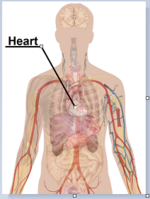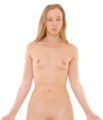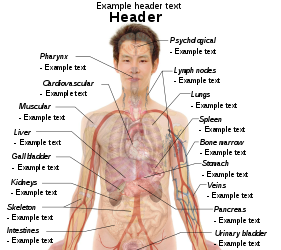File:Surface projections of the organs of the trunk.png
Appearance

Hammi agarsiisa yaalii: pikseelii 374 × 598. Kabiraa furmaatawwan: pikseelii 150 × 240 | pikseelii 300 × 480 | pikseelii 480 × 768 | pikseelii 640 × 1,024 | pikseelii 1,583 × 2,533.
Faayila abbaa (1,583 × 2,533 pixels, file size: 3.33 MB, MIME type: image/png)
Seenaa faayilaa
Faayilicha sa'aa san akka itti mul'atetti ilaaluuf guyyaa/yeroo cuqaasi.
| Guyyaa/Sa'aa | Qeensa abgudduu | Kallattiiwwan | Fayyadamaa | Yaada | |
|---|---|---|---|---|---|
| amma | 09:19, 27 Muddee 2019 |  | 1,583 × 2,533 (3.33 MB) | Mikael Häggström | +Costal margin |
| 10:38, 11 Sadaasa 2010 |  | 1,050 × 1,680 (2.07 MB) | Mikael Häggström | Adapted to recently added overview images. Distinguished different ways to designate vertebrae levels. | |
| 10:04, 7 Sadaasa 2010 |  | 936 × 1,325 (1.77 MB) | Mikael Häggström | update from svg | |
| 09:46, 7 Sadaasa 2010 |  | 936 × 1,325 (1.77 MB) | Mikael Häggström | update from svg | |
| 04:51, 24 Onkoloolessa 2010 |  | 936 × 1,325 (1.61 MB) | Mikael Häggström | Smoother edges | |
| 05:18, 10 Onkoloolessa 2010 |  | 936 × 1,325 (1.61 MB) | Mikael Häggström | Minor kidney adjustment. More realistic hip bone | |
| 04:47, 6 Onkoloolessa 2010 |  | 936 × 1,325 (1.73 MB) | Mikael Häggström | Distinguished stomach and spleen. Removed painted arteries out of scope. | |
| 18:40, 4 Onkoloolessa 2010 |  | 936 × 1,325 (1.74 MB) | Mikael Häggström | Lowered spleen | |
| 15:21, 3 Onkoloolessa 2010 |  | 936 × 1,325 (1.74 MB) | Mikael Häggström | Decreased some opacity. Aligned tail of pancreas with spleen. Adjusted fissure marking width. | |
| 18:20, 2 Onkoloolessa 2010 |  | 936 × 1,325 (1.72 MB) | Mikael Häggström | +liver label |
Fayyadamiinsa faayilaa
Kutaan itti anuu "file"ii kanan walitti qabatta:
Fayyadamiinsa faayila guutu addunyaa
Wikileen biroo kan armaan gadi jiran fayila kana fayyadamu:
- Fayyadamiinsa af.wikipedia.org irratti
- Fayyadamiinsa ar.wikipedia.org irratti
- Fayyadamiinsa as.wikipedia.org irratti
- Fayyadamiinsa bcl.wikipedia.org irratti
- Fayyadamiinsa bn.wikipedia.org irratti
- Fayyadamiinsa bs.wikipedia.org irratti
- Fayyadamiinsa ca.wikipedia.org irratti
- Fayyadamiinsa ckb.wikipedia.org irratti
- Fayyadamiinsa da.wikipedia.org irratti
- Fayyadamiinsa de.wikipedia.org irratti
- Fayyadamiinsa en.wikipedia.org irratti
- Kidney
- Rib cage
- Surface anatomy
- Thorax
- McBurney's point
- Torso
- User talk:Arcadian/Archive 4
- Celiac artery
- Transverse plane
- Abdomen
- Situs solitus
- Transpyloric plane
- Wikipedia talk:WikiProject Anatomy/Archive 2
- Wikipedia:Picture peer review/Trunk anatomy
- Wikipedia:Featured picture candidates/Organs of the trunk
- Wikipedia:Picture peer review/Archives/Oct-Dec 2010
- Wikipedia:Featured picture candidates/November-2010
- Vertebral column
- Talk:Human anatomy/Archive 1
- Fayyadamiinsa eo.wikipedia.org irratti
- Fayyadamiinsa eu.wikipedia.org irratti
- Fayyadamiinsa fa.wikipedia.org irratti
- Fayyadamiinsa fi.wikipedia.org irratti
Mul'isa fayyadama duniyaalessa edaasaa harshama kanaa.
































